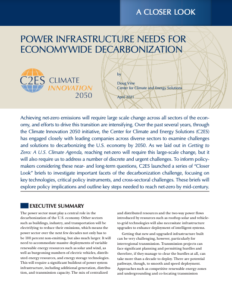Full Title: Power Infrastructure Needs for Economywide Decarbonization
Author(s): Doug Vine
Publisher(s): Center for Climate and Energy Solutions (C2ES)
Publication Date: April 21, 2021
Full Text: Download Resource
Description (excerpt):
The power sector must play a central role in the decarbonization of the U.S. economy. Other sectors such as buildings, industry, and transportation will be electrifying to reduce their emissions, which means the power sector over the next few decades not only has to be 100 percent non-emitting, but also much larger. It will need to accommodate massive deployments of variable renewable energy resources such as solar and wind, as well as burgeoning numbers of electric vehicles, distributed energy resources, and energy storage technologies. This will require a significant buildout of power system infrastructure, including additional generation, distribution, and transmission capacity. The mix of centralized and distributed resources and the two-way power flows introduced by resources such as rooftop solar and vehicle-to-grid technologies will also necessitate infrastructure upgrades to enhance deployment of intelligent systems.
Getting that new and upgraded infrastructure built can be very challenging, however, particularly for interregional transmission. Transmission projects can face significant planning and permitting hurdles and therefore, if they manage to clear the hurdles at all, can take more than a decade to deploy. There are potential pathways, though, to smooth and speed deployment. Approaches such as competitive renewable energy zones and undergrounding and co-locating transmission in existing rights-of-way could be models for making progress in deploying interregional transmission. Siting new non-emitting centralized generation plants near or at the same location as existing or retiring plants can minimize the need for new transmission infrastructure, as can deploying smaller, more distributed power generation resources that are sited closer to demand and within local lower-voltage distribution networks. Energy storage is also emerging as a non-wires alternative to upgrading substations and building new transmission lines, though long-duration storage technologies need to be further developed. Policies and reforms must reduce the need for transmission, help get transmission built, and strengthen transmission connections between regional grids.
